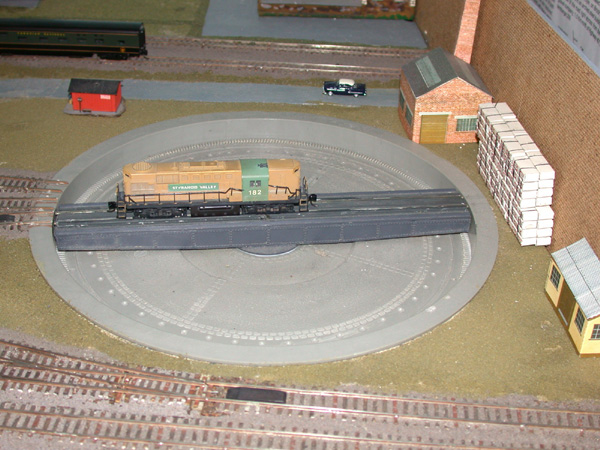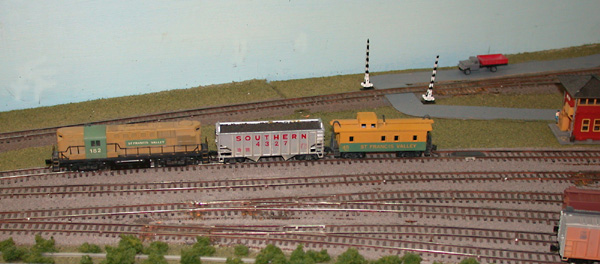Turn that Locomotive
| “Dispatcher, why is Sorel taking such a long time
making up 518 today, he only has one car?” We are on Ken Healy’s St. Francis Valley Railway
and that is the yardmaster Drummondville getting on my case again. 518
is a local freight train with cars from Sorel to Drummondville. The
train is ready but I have been waiting a couple of hours for the power –
the unit off inbound 515 from Drummondville goes back on 518. What takes
the additional time is that the unit has to be turned.
Why is this? It will go just as well backwards as forwards. This particular unit is set up to run short hood forwards. The engineer faces forward and the controls are within easy reach. To run the train in the opposite direction means he has to crane backwards and his visibility is severely restricted. The only thing to do is to turn the unit or to provide a second unit facing the opposite direction but 515 – 518 is normally a light working and management will not provide a second unit. Some diesels, including some on Canadian National, are fitted out to run long hood forward and in this case it is difficult for the engineer to run such a unit on a train with the short hood forward. The reason for running long hood forward seems to have been to afford some degree of protection, similar to a steam locomotive boiler, to the crew in the event of a crossing accident or other obstruction. How do you know which way the diesel is set up? In most cases there is a letter “F” signifying “Front”. This is pretty hard to make out in N scale and the only way is to know. 
With two cabs this diagram worked pretty well. However, a year or so later, I was, by that time, Assistant Station Manager at Reading, I saw the parcels come in late with a Hall 4-6-0 steam engine. It was late because they had had to turn the engine at Didcot. If they needed to turn here and again at Didcot the passenger would be very late indeed. I approached the crew, whom I had worked with a few months previously, and asked them if they would be prepared to run tender first to Didcot, thus saving a lot of time. They were not happy at being given a steam engine instead of the diesel and insisted on turning. I decided to send them round the wye (triangle) rather than going on shed and using the turntable as they wanted – had they gone on shed they might have gone for a brew up. And so the instruction went out that a diesel had to be provided for that working because a steam locomotive could not adhere to the diagram. A tank engine could not be used because the return working from London was a heavy commuter train. 
Now, I have turned the power for 518 and the train is ready to leave. I ask the dispatcher for the road. He contacts Drummondville who cannot accept the train straight away as he is busy with something else. Typical of railway work. Hurry up and wait. Ottawa Valley Associated Railroaders - OVAR, The Interchange, June 2005. |